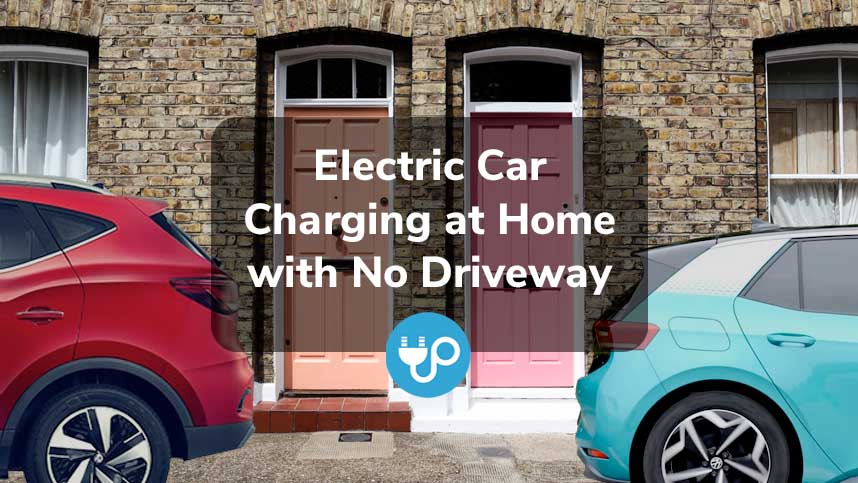
Electric Car Charging at Home with No Driveway – What Can You Do?
In practice, charging an electric car is very straightforward.
Just pull up to the charging station, plug in the EV, charge and then leave.
However in practice, it’s not quite so straightforward.
Furthermore, electric car chargers are not all universal, with many using different types of charging plugs as well as the input rate and type they can handle.
Some electric vehicles have the older Type 1 sockets, whilst newer EVs use Type 2 chargers.
There’s also Tesla vehicles which use their unique superchargers, plus the widely adopted CCS charging socket, and some Japanese and French vehicles using the CHAdeMO combined charging system.
For these reasons, it is much easier and less troublesome to charge at home.
However, not all homes have driveways.
Fortunately, this article explains that car charging with no driveway is possible using some alternative methods.
Chapters
On-Street Charging
On-street charging is an undesirable but serviceable method of charging an electric vehicle.
On-street charging typically involves running an extension cable from the charging station to the vehicle on the street.
Drawbacks involve:
- The threat of vandalism.
- Possible damage to the cord.
- Potential charging issues due to the setup not being a factory-approved method.
There’s also a major health and safety concern, since trailing cables across public pathways are illegal and a potential trip hazard.
So choosing this option requires careful consideration for health and safety legislation.
Run An Extension Cable
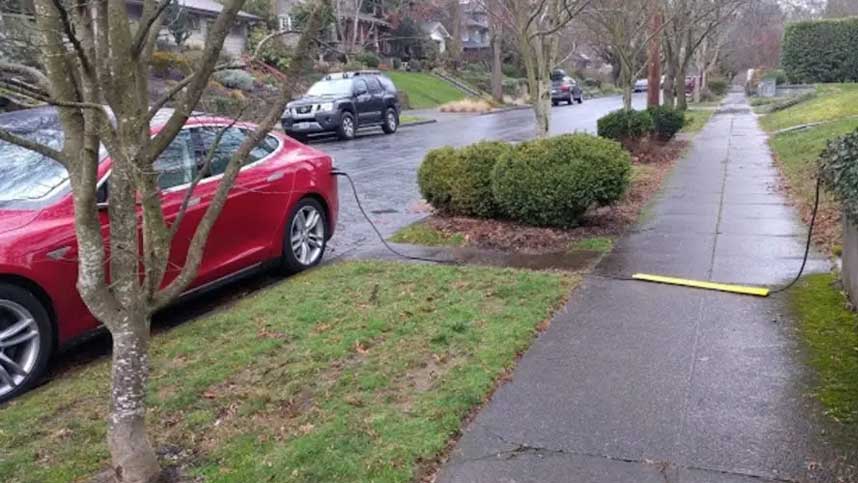
Running an extension cable from the charging station to the car is an acceptable method of electric car charging.
Simply plug in the extension cable, and attach the other end to the EV.
Allow it to charge as necessary.
Using an extension cable to charge an EV is not the best, but it will work.
Ensure the EV is as close to the charging station as possible when charging using an extension cable.
Roadside Charging
Roadside charging is similar to charging with an extension cord.
However, roadside charging usually involves a dedicated charging point, not a cable run from an external socket or the house.
Fortunately, there are some limited roadside charging services available if your EV gets close to running out of charge while on a journey.
Services such as EVBoost provide roadside assistance to stranded EVs, offering either 30-minute roadside charging or towing to a dedicated charging station.
A 30-minute roadside charge equates to 10-15 miles of range in most EVs, so not a great deal.
These services are more designed to give you enough charge to travel to a nearby rapid charging station to charge your EV to full.
Unfortunately, EVBoost operates in the UK and Ireland only, and not the mainland Europe.
Lamppost Charging
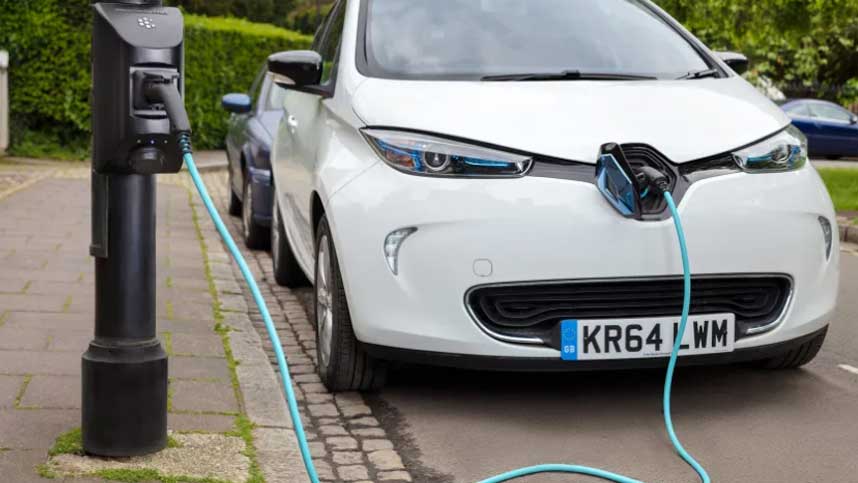
Lamppost EV charging is not yet widely available anywhere in the world, as it is still in trials.
Lamppost EV charging refers to a small charging station hidden within a lamppost.
The EV can be charged from the lampost, and the charging cable stores within the post when not used.
Due to the need for wiring and charging infrastructure to support the idea, lamppost EV charging is not widely available as yet.
However, lamppost EV charging will become easy, affordable, and convenient for any EV owner when it becomes available, especially for motorises without a driveway.
On-Street Residential Chargepoint Scheme
An on-street residential charge point scheme aims to install charge points in easily accessible, street-side locations.
This scheme will be implemented across the UK and EU.
Installing chargers in accessible locations will make EV ownership far less troublesome and increase EV uptake, thus driving up sales.
Workplace Charging
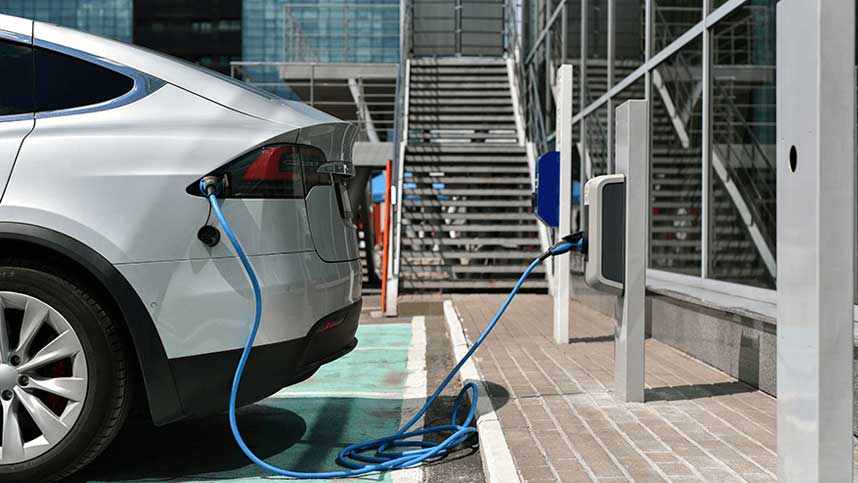
Charge points at workplaces provide incentives to purchase and drive EVs, as they are conveniently located at the office or place of business.
Workplace charging also ensures your EV has a full battery for the return journey home at the end of the working day.
It’s the ultimate in commuter convenience. No more stopping to charge up!
Workplace charging points offer huge incentives to purchase an EV, as there will be a guaranteed charge point at your most visited destination.
Workplace charge points also eliminates range anxiety and removes the single biggest barrier to buying an EV, which is the perceived lack of charging stations.
Public Charging Points
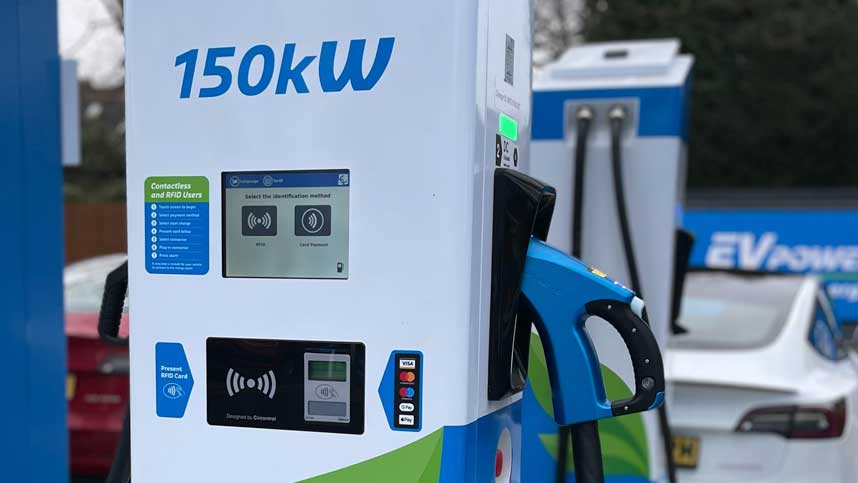
Public charging points provide a convenient place to charge your EV.
In addition, most charging stations accept Type 2/Chademo/DC fast charger adapters, making charging relatively simple.
However, payment methods and charging adapters are not standardized across all charging points in the UK or the EU.
Many public chargers require the installation and set up of an app with a verified account, whilst others do accept contactless payments.
But with no universally accepted method of using public chargers, it does cause a lot of inconvenience having to install and set up dozens of different apps.
Therefore, it’s critical to determine what type of charger your EV uses and plan your charging sessions around compatible chargers in the area.
Thai means planning your charging stops in advance which is never easy, and never goes according to plan.
Some EVs have optional charging adapters to make charging at different stations easier, but nothing can be done if they are in use when you arrive.
You either have to wait, or drive to another nearby public chargepoint hoping it will be vacant.
Car Park Charging
Car park charging is a convenient and safer method of charging your EV when traveling.
A charger-equipped car park will have a row of EV charger spaces reserved, with accompanying charger stations.
Many car park chargers are Tesla Superchargers, but Type 2/CHADEMO/DC fast chargers can also be found in car park charging stations.
Car park chargers are convenient, allowing EV owners to charge the battery while shopping and replenish lost range.
Rapid Charging Hubs
High-speed charging hubs provide locations for EV owners to quickly replenish their batteries before continuing their journey.
According to Fleet News, the UK gained 106 high-speed EV charging hubs in 2022.
A high-speed charger reduces charge time from up to 8 hours all the way down to 30-45 minutes for a maximum charge.
High-speed chargers deliver current at rates varying from 15kwh to 350kwh.
However, the energy delivered at such a high rate can decrease battery life over extended periods.
Therefore, it’s a form of preventative maintenance that allows an EV to charge regularly for more extended periods.
In addition, this practice will aid in preserving battery life.
Destination Charging
Charging at your destination is a critical step when making journeys in an EV.
Like refueling a classic car at the destination, recharging at the destination allows the driver to depart with a full battery, reducing range anxiety and providing a safer overall journey.
However, destination charging is an EV charger network operated by Tesla, exclusive to Tesla owners.
There are over 35,000 destination chargers worldwide.
Destination charging is intended for Tesla owners on journeys, so their Teslas may charge overnight or for extended periods during the day.
Destination charging is only accessible to Tesla owners.
Charger Sharing Schemes
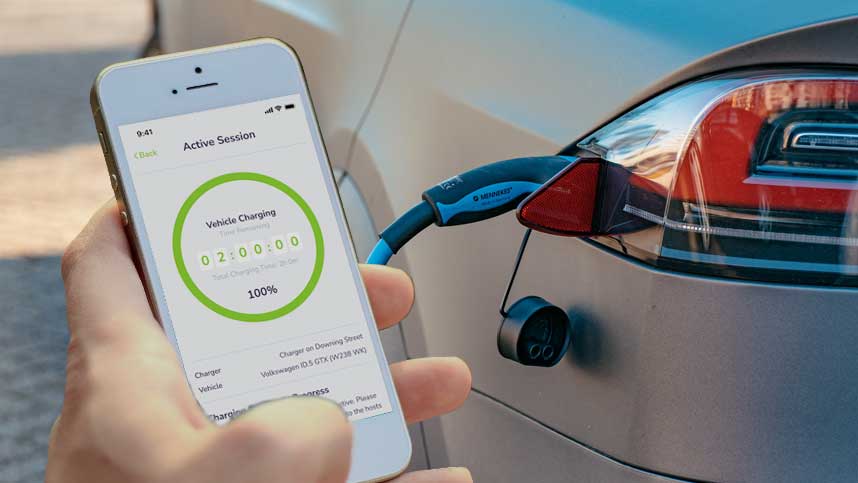
Charger-sharing schemes aid in growing EV charger infrastructure and provide additional incentives to purchase an EV.
EV owners can participate in charger sharing schemes and allow other owners to use their community-based chargers during off-peak hours for a small fee.
Any UK-based EV owners wishing to participate can sign up through charger sharing apps like Joosup.
Charger-sharing schemes help grow EV infrastructure and provide more options for EV owners when traveling.
Key Takeaways
For most EV owners, electric car charging at home is usually the preferred method of keeping an EV juiced up.
So for those without a driveway, owning an EV may seem unattainable.
However, driveway charger sharing, street charging, roadside charging, and lamppost charging are all viable solutions when traditional charging stations are not available.
Whilst not ideal, charging with no driveway is not the end of the world and it can be done.
With a little research, you’ll soon discover there’s a whole world of alternative charging options out there.
Blog Archive
- Electric Car Tyres – All You Need to Know
- Are Electric Cars Cheaper to Run?
- Do Electric Cars Use Oil?
- 70% of UK Councils Have No On-Street EV Charging Plans
- Joosup + waEV-Charge: Electrifying the Future Together!
- What is an EV Battery Lease?
- 8 Great Reasons to Share Your EV Charger
- What is OZEV?
- What is ULEZ Compliant?
- Electric Car Charging at Home with No Driveway – What Can You Do?
- EV Home Charger Installation for Beginners
- How to Drive an Electric Car
- What is Range Anxiety & How Do We Defeat It?
- What is Destination Charging?
- What is a CHAdeMO Charger?
- What is CCS Charging?
- What is Peer to Peer EV Charger Sharing?
- Types of Electric Car Plugs Explained
- What is Community Charging?
- How Long Does It Take to Charge an Electric Car?

